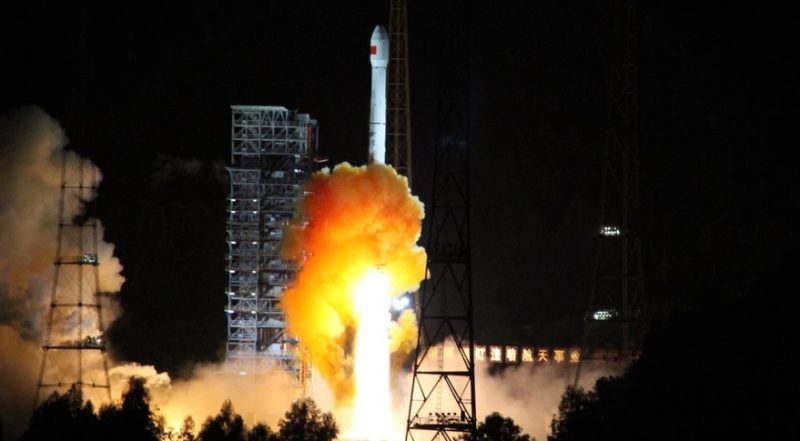
Rocket debris to strike the moon today
In January, experts said part of a SpaceX Falcon 9 rocket was due to crash into the moon on March 4. Then, they said, it wasn’t a SpaceX rocket, but instead a Chinese rocket. But the Chinese denied it was theirs. So is any human spacecraft going to strike the moon on March 4? The answer now appears to be yes. An earthly object is headed for a collision course with the moon on March 4. But we still don’t know, and might never know, exactly where and how it originated.
Here is Bill Gray's map of the predicted impact site on the Moon pic.twitter.com/wr3XkZQrW5
— Jonathan McDowell (@planet4589) March 4, 2022
Confusion reigns
There’s plenty we don’t know about the object that’s about to hit the moon. Namely, what is it and where did it come from? But there’s also plenty that we do know. This piece of space junk is traveling at 5,800 miles per hour (9,300 km/h). It’s headed for the Hertzsprung crater on the far side of the moon, sometimes erroneously called the dark side (no part of the moon is ever perpetually in darkness, because the moon spins on its axis, albeit slowly).
When the object hits the moon on March 4, it won’t make much of an impact besides a new, albeit small, crater and its remains. The new crater will be about 20 meters (66 feet) across. This will be the first known-in-advance, unintentional debris impact with the moon.
The 2022 lunar calendars are still available. Order yours before they’re gone!
Still a Chinese rocket?
There is a chance that the object poised to hit the moon is still a Chinese rocket. After experts cleared SpaceX as being the source of the debris, they said it was a rocket stage from the 2014 Chang’e-5 T1 mission. China claimed on February 21 that this was not the case, because their rocket burned up on reentry.
On the one hand, the Space Force’s 18th Space Control Squadron’s space-tracking data agrees that the rocket stage reentered our atmosphere in 2015. And on the other hand, NASA’s Jet Propulsion Laboratory’s Center for Near-Earth Object Studies said the object is likely the 2014 Chang’e 5-T1 booster. Plus, students at The University of Arizona conducted spectral analysis on the wayward object and believe it to be the Chinese rocket.
Regardless of what it is and who set it in motion, the object’s end is in sight.
Can we see the impact?
No, we can’t see the impact due to it being a small rocket and, more importantly, occurring on the far side of the moon. But we may possibly learn more about the impact and resulting crater and debris someday, whether through future missions or current ones, such as the Lunar Reconnaissance Orbiter (LRO).
NASA told Space.com that they’re assessing whether a future flyby of the LRO might spot changes in the lunar surface from the impact. As the organization said to Space.com:
This unique event presents an exciting research opportunity. Following the impact, the mission can use its cameras to identify the impact site, comparing older images to images taken after the impact. The search for the impact crater will be challenging and might take weeks to months.
More on how the rocket was misidentified
How did we know that anything was going to strike the moon at all? As Bill Gray explains on his website, various countries carefully track objects in low-Earth orbit because there are so many pieces of debris with risks of collision with military and science satellites. Farther from Earth, there is less tracking. Or, as Gray said:
Generally speaking, high-altitude junk goes ignored. (Except, it appears, by me.)
Gray works with asteroid hunters. As he said:
My ‘day work’ is for the asteroid-hunting community … Most artificial objects are close to the Earth and move fast enough that there is no risk of mistaking them for an asteroid. But there are about a dozen ‘high-flying’ objects that can move slowly enough to look like a rock, at least briefly. For about fifteen or twenty years now, I’ve taken these observations and computed orbits. Then, when the surveys find such objects, they can fairly quickly say ‘Never mind; it’s not a rock; it’s just another nuisance artificial object,’ and go back to looking for actual rocks.
Not enough people tracking space debris
So there aren’t many people tracking space debris that’s far from Earth. As Ed Trollope, a spacecraft engineer, said on Twitter, the debris:
is not always tracked since the moment of launch, and nothing can be tracked constantly. An object gets detected, the trajectory calculated, and worked backwards to ID where it came from. Many are unknown.
When asked if everything that launched should have trackers attached, he said:
How would you power this ‘tracker?’ We’re talking about bits of debris here, not functional satellites. There is a huge amount of work being done to improve our current capabilities in this area. Here’s a good starting point if you’d like to learn more.
Bottom line: Yes, a rocket will strike the moon on March 4, 2022. It’s not a SpaceX Falcon 9 rocket. It may be a Chinese rocket that launched in 2014, but the answer is unclear.
Via Arstechnica, Space.com, SpaceNews, The Planetary Society, Bill Gray











